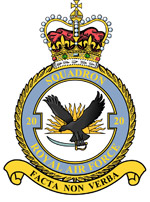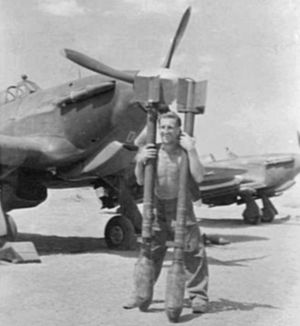No. 20 Squadron RAF facts for kids
Quick facts for kids No. 20 Squadron RAF |
|
|---|---|

Squadron badge
|
|
| Active | 1 September 1915 - 1 August 1947 11 February 1949 - 16 September 1951 14 June 1952 - 30 December 1960 1 September 1961 - 13 February 1970 1 December 1970 - 31 July 1992 1 September 1992 - 31 March 2010 1 June 2021 - Present |
| Country | |
| Branch | |
| Type | Operational Conversion Unit |
| Role | Air Surveillance and Control System training |
| Home station | RAF Boulmer |
| Motto(s) | Latin: Facta non verba ("Deeds not Words") |
| Battle honours |
|
| Insignia | |
| Squadron Badge heraldry | In front of the rising sun, an eagle, wings elevated and perched on a sword. The rising sun is intended to commemorate the unit's long association with the Asia. The eagle is perched on 'Talwar' indicative of the Squadron's work with the Army in India. |
| Squadron Roundel |  |
No. 20 Squadron is a special training unit of the Royal Air Force (RAF). It teaches people how to manage air battles and control aircraft from the ground. This unit is part of the RAF's Air Surveillance and Control System (ASACS). It is based at RAF Boulmer in the UK. The squadron took on this important role on June 1, 2021.
Before this, No. 20 Squadron was a flying squadron. Its last job was training pilots for the UK's Joint Force Harrier. From 1992 to 2010, the squadron flew Harrier jets from RAF Wittering.
Contents
Squadron History
World War I Adventures (1915-1918)
No. 20 Squadron started on September 1, 1915, in Netheravon, England. It was part of the Royal Flying Corps, which was the UK's air force at the time. In 1915, planes were becoming very important for finding out what the enemy was doing. The squadron was formed to help with this.
On January 16, 1916, the squadron flew to France. They used FE2B planes, which were two-seater aircraft for fighting and looking around. Later, they got improved FE2D models. No. 20 Squadron worked with the British Army near Ypres. Their jobs included flying patrols, taking photos, and bombing targets day and night.
The squadron had many successful air battles. One famous event happened on July 6, 1917. A pilot from No. 20 Squadron, Second Lieutenant Woodbridge, was the first British airman to wound the famous German pilot Manfred von Richthofen, also known as the Red Baron.
The pilots and crew of No. 20 Squadron showed great bravery. They received 71 awards for their courage. One very special award, the Victoria Cross, was given to Acting Flight Sergeant Thomas Mottershead. He was honored after he died from injuries he got during a combat mission on January 7, 1917.
The squadron continued to fly from airfields near Ypres. In September 1917, they got new planes called Bristol Fighters. These planes were much better and the squadron used them for the next 15 years. In April 1918, the Royal Flying Corps became the new Royal Air Force, and No. 20 Squadron joined it.
Serving in India (1919-1941)
After World War I, in May 1919, the Afghan Army invaded India's North-West Frontier Province. No. 20 Squadron was sent to India to help. They arrived at RAF Risalpur in June 1919. They were the first squadron in India to fly the Bristol Fighter.
Even after the invasion was stopped, No. 20 Squadron stayed in the Northwest Frontier region. Their new job was "Air Control." For the next 20 years, they were mostly based at RAF Peshawar. They often moved to other places like Miranshah and Shabkadar. The squadron developed new ways to use planes to help control the area. Their Bristol Fighters flew missions to gather information for the army.
The squadron also helped people in peaceful ways. In 1929, they helped with the Kabul airlift. This was when planes rescued people from Kabul. No. 20 Squadron planes helped guide the transport aircraft. In 1935, they flew medical supplies and doctors to Quetta after a big earthquake. They also flew vaccines to Kabul in 1936.
A famous writer and army officer, T. E. Lawrence, also known as Lawrence of Arabia, worked with No. 20 Squadron in 1928. He was a clerk at their airfield in Miranshah. He was later moved away because news stories in London said he was involved in politics, which could have caused problems.
In the 1930s, the squadron updated its planes. They first got Westland Wapitis in 1932, and then Hawker Audaxes in 1935.
World War II Efforts (1941-1945)
When World War II started, No. 20 Squadron continued its work in India. After Italy joined the war, protecting India's ports became very important. In 1941, parts of the squadron moved to Bombay and Madras to help defend the coast.
In December 1941, the squadron got new planes called Westland Lysanders. These planes were used to work with the army. When Japan attacked Burma in early 1942, British forces had to retreat. No. 20 Squadron moved closer to the fighting in Burma.
Throughout 1942 and 1943, the squadron flew its Lysander planes to support the army in Burma. Even though the Lysanders were old, the squadron flew dangerous missions. They flew low to the ground to avoid Japanese fighters. They also helped with Air-Sea Rescue missions.
In May 1943, No. 20 Squadron got powerful new planes: Hurricane IIDs. These Hurricanes had two large 40mm cannons under their wings, perfect for destroying tanks. The squadron trained on these new aircraft.
For the next seven months, No. 20 Squadron operated in Burma. They were the only squadron with Hurricane IIDs. Their main job was to attack enemy tanks and vehicles. They also attacked supply routes like river boats and trucks. In April 1944, they helped fight in the Battle of Imphal.
Later in 1944, the squadron moved to different airfields for rest and training. They also helped spray areas with chemicals to stop malaria. In December 1944, some of their Hurricanes were fitted with rockets. As the Allied armies advanced through Burma, No. 20 Squadron continued to attack enemy positions. After the capture of Rangoon in May 1945, the squadron stopped operations. They were preparing to move to the Far East when World War II ended.
Cold War Operations (1945-1992)
After World War II, No. 20 Squadron moved to Thailand and got new planes called Spitfire XIVs. By April 1946, they were in India and flying Tempest FBII planes. The squadron was disbanded in August 1947, just before India became independent.
The squadron was reformed in 1949. It flew different types of aircraft to help train anti-aircraft gunners. They would act as targets for practice. In 1951, it was disbanded again.
In 1952, No. 20 Squadron was reformed in Germany. They flew Vampire jets for air defense and ground attacks. To counter new Soviet planes, they soon got faster Canadair Sabre jets in 1953. Later, they flew Hawker Hunter jets. The squadron disbanded again in 1960.
However, the squadron was quickly reformed in Singapore in 1960. They flew the Hunter FGA9, a special version for ground attacks. For the next 10 years, they were based at RAF Tengah. They trained regularly and went on missions to places like Hong Kong and Thailand. During the Indonesian Confrontation, they helped defend Malaysia from attacks. In 1969, they even added some Pioneer planes to help guide their Hunter jets. The squadron was disbanded in February 1970 as the UK reduced its military presence in the region.
No. 20 Squadron reformed in Germany in December 1970. They became the second squadron to fly the Harrier GR1 jet. These jets were used to support NATO forces. In 1975, they got updated Harrier GR3s. In 1977, the squadron handed over its Harriers to another squadron.
The very next day, No. 20 Squadron reformed with Jaguar GR1 jets. They continued to support NATO forces in West Germany. These Jaguars could carry conventional weapons and also some tactical nuclear bombs. The squadron was ready to help if a conflict in Europe became very serious.
In 1984, the squadron got new Tornado GR1 jets. They kept their role of supporting ground forces and could carry even more weapons.
In November 1990, the squadron went to Saudi Arabia to take part in Operation Granby, which was the UK's part in the Gulf War. They attacked Iraqi airfields and used a new missile called ALARM. No. 20 Squadron returned to Germany in March 1991. Due to changes in the British military, No. 20 Squadron was disbanded as a Tornado squadron in July 1992.
Training Unit (1992-2010)
On September 1, 1992, the Harrier training unit at Wittering was renamed No. 20 (Reserve) Squadron. The "Reserve" part meant that even though it was a training unit, its planes and staff could be used for real operations if needed.
In 2000, No. 20 Squadron became part of Joint Force Harrier, which combined the RAF and Royal Navy Harrier squadrons. The squadron stayed at RAF Wittering for 10 more years. In 2010, Joint Force Harrier was reduced in size. No. 20 Squadron was disbanded in March 2010. Later that year, Joint Force Harrier itself was disbanded.
ASACS Training Today (2021-Present)
On June 1, 2021, the No. 20 Squadron name was given to the RAF's Air Surveillance and Control System (ASACS) training unit. This unit is based at RAF Boulmer in Northumberland.
The ASACS training unit teaches British military staff how to manage air battles. They learn to watch, find, and identify all aircraft flying in and around UK airspace. They also learn how to coordinate Quick Reaction Alert aircraft, which are jets ready to respond quickly to any threats.
Aircraft Operated
|
|
See also
- List of Royal Air Force aircraft squadrons


